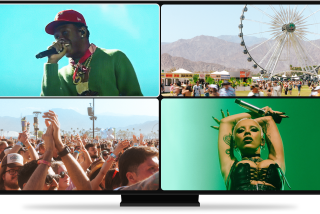Oh, look, a train and schoolwork
YOUTUBE is about to hit 75 million videos. At the beginning of February, it had 70 million. YouTube told me recently that 10 hours of new video are uploaded every minute. And that every day, the site gets -- their words -- “hundreds of thousands” of new videos.
On a real red letter day I’ll watch maybe 25 videos (and remember, it’s my job). But if you figure 200,000 a day get put up on YouTube -- that’s about one-hundredth of 1%.
The videos most of us watch are the ones that have tipped into the mainstream -- the bizarre, hilarious or sensational most-viewed clips that have become today’s preferred water-cooler fodder.
But those videos are really just a pinch of sand from a mile-long beach -- the tiniest, least representative fraction of what gets uploaded every day. What YouTube is truly made of is the stuff no one ever sees -- stuff not meant for, or wanted by, the public.
The sheer mathematical unlikelihood of any single video getting more than a few views -- especially if there’s nothing special about it -- provides users with a kind of safety-in-numbers. A lost-in-the-crowd type of privacy.
And in many ways, that privacy is real. The Internet is such a search-oriented medium that happening upon something you’re not already looking for -- and that isn’t already popular or featured somewhere else -- is exceedingly rare. We all stumble upon content we didn’t expect to find -- but it’s usually the same content everyone else is stumbling on. Just so for YouTube, and the thousands of people who upload videos of their toddler dancing every day must intuitively understand this. Many of us would tsk at the notion of putting a photo of our child on the open Internet. But really: How is anyone ever going to know it’s there?
The de facto privacy is even stronger if you leave out identifying information. So if someone searches your child’s name, it won’t match the video. The only way to find it is to know its Web address.
Well, there’s one other way. Before videos sink into the Abyssopelagic depths of YouTube, you can catch a glimpse of them by simple dint of their being brand new. If you search YouTube for “*” -- the asterisk is computer-speak for everything -- and then order the results by date, you’ll get a list of the newest videos from around the world. Now instead of being the millionth person to see a vid, you could be the first.
And you may be the only.
Hiding amid all the junk and noise then is a truth that doesn’t get much attention: Despite the hand wringing of people concerned that YouTube is polluting, diluting and dumbing down our culture, turning us all into craven, attention-deficit-disordered attention-whores, in the main, people aren’t using YouTube to perform, or to make a splash, or to be discovered. They’re using it for personal stuff.
This isn’t entirely surprising. When Johnny takes his first steps, being able to e-mail family members a link to the YouTube video is easier than burning the footage onto DVDs and mailing it to five addresses
But then there’s stuff you actively would not want anyone to see -- like the YouTube penpalship I found between two teenagers.
It was a “private” video correspondence -- not a performance blog. The girls did not expect anyone to watch it, and according to the videos’ view counts, all between one and 10 -- no one did. Until I found them. [See the sidebar at right for more on their correspondence.]
The second major use of YouTube appears to be as a kind of personal video scrapbook, in which people keep the little video clippings we’ve all begun to generate.
In this category, cellphone videos reign. Because almost everyone’s got a video camera in their pocket now, we can instantly satisfy the primal desire to record anything even slightly out of the ordinary. There’s a character in an essay by David Foster Wallace about a guy on a sea cruise whom Wallace dubbed “Captain Video” because he was never not recording -- he’d even stand on the deck and record the empty ocean -- as though he didn’t want to lose any of those special maritime memories.
The 10-, 20-, 30-second cellphone video clips are the video equivalent of bad snapshots, in which the sunset looked great when you clicked the shutter, but when you got it back from the lab, it failed utterly to capture the wonder of the moment.
Mankind and his ready camera are generating billions of bad snapshot and snap-videos a year now. A philosophical question for our time is: Once you’ve seen the boring 30-second video you took, why would you still go to the trouble of uploading it to the Internet? It seems as if every third YouTube video is a short shot of a crowd dancing at a concert, or a guy sliding down a snowy hill on a trash-can lid (not fast), or a big brother wrestling his little brother to the ground, or someone getting on the subway.
It’s probably time to stop treating YouTube as if it’s nothing but talking cats, funky video bloggers and clips from last night’s “Moment of Truth.” That is a minuscule and unrepresentative sample of what the site truly contains.
Because what YouTube contains is “*”: everything.
YouTube’s founding idea is that video doesn’t like being trapped in a physical container. It wants to be communicated, watched, enjoyed. So it’s only natural that all the video in the world is migrating to the only place everyone can see it. Even if no one ever does.
--






